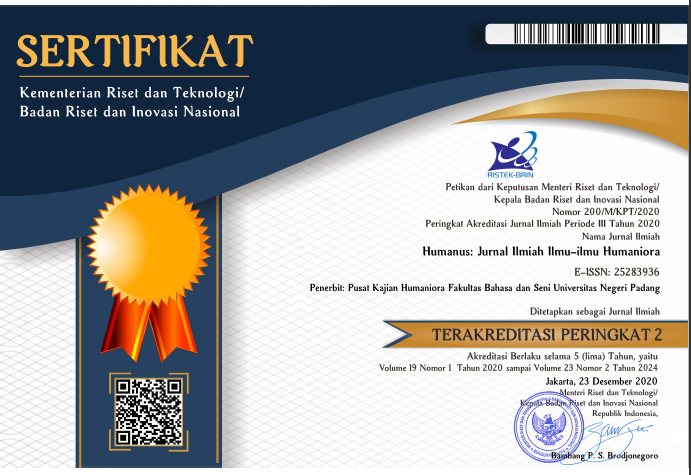Reception of Digital Novel Readers (Role of Indonesian Readers in Wattpad Application)
 ), Nini Ibrahim(2), Fairul Zabadi(3), Fauzi Rahman(4),
), Nini Ibrahim(2), Fairul Zabadi(3), Fauzi Rahman(4), (1) Universitas Muhammadiyah Prof. Dr. Hamka
(2) Universitas Muhammadiyah Prof. Dr. Hamka
(3) Badan Riset dan Inovasi Nasional
(4) Universitas Indraprasta PGRI
 Corresponding Author
Corresponding Author
Copyright (c) 2022 Humanus
DOI : https://doi.org/10.24036/humanus.v21i2.117832
Full Text:
 Language : en
Language : en
Abstract
In digital novels, readers get a room for comment, give a suggestion, or just give hope herself regarding the novel, for instance about characters, settings, and plot creation. The aim of this study is for finding the perception reader to digital novels. This method used of this Study is qualitative descriptive. The Research data sources are from the novels of Wattpad app with the most reader status from 3 selected novels randomly i.e Dosen Bucin, Still, I Do, and Mantan Kakak Ipar Rasa Pacar. the study used pragmatics approach. Pragmatics Approach is used because in the study this aim is for investigating the response of readers through aesthetics reception Jauss on literary texts in Novels on Wattpad. Techniques used to collect data in the study is a watch notes and a study bibliography. Research results show that the most dominant reception lies in thesis 2. This domination reaches the percentage of 71.5% which means that is at a high level. Thesis 2 in Jauss literary reception have meaning that a literary work can awaken the memory of the reader so that it creates a special emotional attitude. In this context, the reader has a horizon of expectations at the beginning, middle, and end stages of the content of the literary work. The process of receiving the text (reading process) is the reader's subjective impression (awakening the reader’s memory and appearing attitude emotional).
Keywords
References
Andriyani, N., & Piliang, W. S. H. (2019). Kritik Sastra Ekologis Terhadap Novel-Novel Terbaru Indonesia. GERAM, 7(1), 81-89.
Boyd, B. (2018). The evolution of stories: from mimesis to language, from fact to fiction. Wiley Interdisciplinary Reviews: Cognitive Science, 9(1), e1444.
Danyati, R. (2018). Penerapan Mimesis Dalam Novel Empress Orchid Karya Anchee Min (Penelitian Analisis Isi). SNIT 2018, 1(1), 1-8.
Fukuyama, M. (2018). Society 5.0: Aiming for a new human-centered society. Japan Spotlight, 1, 47-50.
García-Roca, A. (2020). Spanish Reading Influencers in Goodreads: Participation, Experience, and Canon Proposed. Journal of New Approaches in Educational Research (NAER Journal), 9 (2), 153-166.
García-Roca, A. (2020). Virtually Digital Reading: The Collective Challenge of Textual Interpretation. Moebio ribbon, (67), 65-74.
Herfanda, A. Y. (2018). Membentuk Karakter Siswa dengan Pengajaran Sastra. Jurnal Tuturan, 1(1), 1-13.
Intan, T. (2019). Resepsi Remaja Perempuan Pembaca Novel Populer. Metahumaniora, 9(2), 157-167.
Jauss, H.R. (1983). Toward an Aesthetic of Reception. Minneapolis: University of Minnesota
Juodeika, R. (2022). Valerijaus Podorogos mimesis samprata: jusliniai teksto suvokimo aspektai. Problemos/Problems, 101.
Kiššová, M. (2015). Mimesis, interpretation, and the human condition. Ars Aeterna, 7(2), 1-22.
Maulinda, R. (2021). Nilai Mistis Dan Mitos Yang Terkandung Dalam Novel Kkn Di Desa Penari Karya Simpleman. JUrnal Metamorfosa, 9(1), 30-41.
Muslimin, M. F. (2020). Elemen Naratif Novel 5cm Karya Donny Dhirgantoro Dan Horizon Harapan Pembacanya. tuahtalino, 14(2), 210-222.
Muzakki, A. (2007). Karya Sastra: Mimesis, Realitas Atau Mitos?. LiNGUA: Jurnal Ilmu Bahasa dan Sastra, 2(1).
Nahdhiyah, N., Rahman, F., & Herawaty, H. (2022, February). The Role of Learning Literary Work in Enhancing the Awareness of Loving Nature. In 67th TEFLIN International Virtual Conference & the 9th ICOELT 2021 (TEFLIN ICOELT 2021) (pp. 296-301). Atlantis Press.
Noor, R. (2017). Minat, motif, tujuan, dan manfaat membaca novel teenlit bagi remaja jakarta: studi resepsi sastra. Nusa: Jurnal Ilmu Bahasa dan Sastra, 12(1), 81-89.
Nur’Aini, E. (2018). Analisis Resepsi Pembaca Terhadap Novel Intelegensi Embun Pagi Karya Dewi Lestari Dalam Komunitas Cybersastra. University of Muhammadiyah Malang.
Osterman, M. D. (2013). Digital literacy: Definition, theoretical framework, and competencies.
Piorecký, K., & Malínek, V. (2020). Czech Literary Culture in the Post-Digital Era. Porównania, 27(2), 267-288.
Pradopo, R. D. (2021). Teori kritik dan penerapannya dalam sastra Indonesia modern. UGM PRESS.
Putri, W., Mursalim, D. D., & Dahlan, D. (2020). Tanggapan Remaja di Samarinda terhadap Novel Populer Jingga dan Senja Karya Esti Kinasih: Kajian Resepsi Sastra. Ilmu Budaya: Jurnal Bahasa, Sastra, Seni, dan Budaya, 4(2), 201-210.
Putri, W., Mursalim, D. D., & Dahlan, D. (2020). Tanggapan Remaja di Samarinda terhadap Novel Populer Jingga dan Senja Karya Esti Kinasih: Kajian Resepsi Sastra. Ilmu Budaya: Jurnal Bahasa, Sastra, Seni, dan Budaya, 4(2), 201-210.
Qur’ani, R. R. N. (2022). Implikasi Konflik Dalam Novel Bisikan Dari Langit Karya Galang Lufityanto: Pendekatan Struktural. JOEL: Journal of Educational and Language Research, 1(8), 1207-1224.
Rajathi & Kalamani (2020). Digital Literature: A Literary Trend of The Twenty-First Century. IJAR. 8(11).
Ratna, N.K. (2013). Teori metode, dan teknik penelitian sastra : dari strukturalisme hingga postrukturalisme perspektif wacana naratif. Yogyakarta: Pustaka Pelajar.
Rodríguez, F. (2013). La noción de género literario en la teoría de la recepción de Hans Robert Jauss. Revista Comunicación, 11(2).
Saidin, F. H., & Ahmad, J. H. (2015). Kajian Teori Transportasi ke Atas Pembacaan Novel dalam Kalangan Remaja. Jurnal Komunikasi Borneo (JKoB).
Saltarelli, T. (2012). The issue of mimesis in Brazilian colonial literature. Abriu: textuality studies of Brazil, Galicia, and Portugal, (1), 79-92.
Seles, S. (2019). Analisis Perbandingan Novel “Mutiara di Kota Melbourne” dan “Four Seasons In Belgium” dengan Pendekatan Mimetik. Disastra: Jurnal Pendidikan Bahasa dan Sastra Indonesia, 1(1), 33-40.
Sukirman, S. (2021). Karya Sastra Media Pendidikan Karakter bagi Peserta Didik. Jurnal Konsepsi, 10(1), 17-27.
Turaeni, N. N. T. (2019). Orientasi Kritik Sastra “Puisi” Dalam Rubrik Budaya Surabaya Post. MEDAN MAKNA: Jurnal Ilmu Kebahasaan dan Kesastraan, 14(2), 181-196.
Vala, J. (2012). The Research on the Reception of Poetry in Students Aged 12–15. Procedia-Social and Behavioral Sciences, 69, 675-681.
Wahyuningsih, S. (2017). Teori katarsis dan perubahan sosial. Jurnal Komunikasi, 11(1), 39-52.
Widyaningrum, H. K. (2018). Analisis Tokoh pada Cerpen “Ibu Pergi Ke Laut” Melalui Pendekatan Kritik Mimetik Serta Relevansinya dengan Pembelajaran Sastra Di Sekolah Dasar. Bahastra. 38(1).
Wright, D. T. H. (2020). Collaboration and authority in electronic literature. TEXT, 24(Special 59), 1-12.
Wulandari, R. A. (2015). Sastra dalam pembentukan karakter siswa. Jurnal Edukasi Kultura, 2(2), 63-73.
Yanti, P.G., Ibrahim, N., (2021). Bentuk Ketidakadilan Gender dalam Novel-novel Digital. Universitas Muhammadiyah Prof. Dr. Hamka.
Zhao, N., Wu, M., & Chen, J. (2017). Android-based mobile educational platform for speech signal processing. International Journal of Electrical Engineering Education, 54(1), 3-16.
 Article Metrics
Article Metrics
 Abstract Views : 652 times
Abstract Views : 652 times
 PDF Downloaded : 235 times
PDF Downloaded : 235 times
Refbacks
- There are currently no refbacks.
Copyright (c) 2022 Humanus

This work is licensed under a Creative Commons Attribution-NonCommercial 4.0 International License.










